|
|

By Jo Nova
The term “Net Zero” has become a dirty word
It’s a win. The climate wars will rage on, but the Net Zero spell isn’t working any more, so they will have to find a newer one without such a smell. The sacred propaganda term that was going to save all life on Earth until five minutes ago is more than just a worn out advertising slogan, the skeptics campaign against it has made it a toxic term. Like ESG, it’s become a liability.
The people know “Net Zero” is not just a fluffy footprint on a forest, but an attack on their wallet and their lifestyle. It’s a great credit to GWPF and NetZeroWatch in the UK for turning this phrase back against the infinitely well funded financial-house-and-government-alliance.
The Guardian (of the ruling class)
The concept of “net zero” has become a political slogan used to start a “dangerous” culture war over the climate, and may be better dropped, the outgoing head of the UK’s climate watchdog has warned.
“Net zero has definitely become a slogan that I feel occasionally is now unhelpful, because it’s so associated with the campaigns against it,” he said. “That wasn’t something I expected.”
Politicians on all sides are now wary of associating themselves with the term, he said, which was inhibiting progress.
The scare stories worked. Look at the backpedaling on meat and flying:
Tackling the climate crisis has been presented as a massive change, but Stark was at pains to point out that it would not be. “The world that we’ll have in 2050 is extremely similar to the one we have now. We will still be flying, we’ll still be eating meat, we will still be warming our homes, just heating them differently,” he said. “The lifestyle change that goes with this is not enormous at all.”
Now they are trying to tell us it will be easy to change the weather?
This is part of the big backdown we’ve seen in so many theatres. First ESG became a dirty word, now “Net Zero” is too. Money is fleeing from “sustainable investments”. EV’s are on the nose. It’s the end of an era that started (as best as I can tell) around 2015 and the Paris agreement and has been hammered for the last five years.
 … But make no mistake, the freeloading barnacles of bureaucracy and banking will transmogrify, and they will hide their intent a little more carefully. In Australia, after the Carbon Tax became a dirty term (when Tony Abbott won in a landslide) the tax returned under many guises, but it was never called a Carbon Tax again. Among many names, it became The SafeGuard Mechanism, where an emissions trading scheme was legislated unbenownst to nearly everyone. Now they want to impose a fossil fuel tax. They are barely hiding it.
After years of failure at UN junkets to set up international emission trading schemes, which also got themselves a bad name, the EU has set up a Carbon Border Adjustment Mechanism. These carbon tariffs will take money from foreign countries to make their own emissions trading scheme workable.
And just like all the other taxes, the media sycophants tell us we will “prosper” with an international carbon price. (Just as soon as we figure out how to smelt steel with solar panels.)

10 out of 10 based on 40 ratings
Long live Elon Musk
10 out of 10 based on 19 ratings
By Jo Nova
In the Bermuda Triangle of electricity bills, the more cheap generators you add, the higher your electricity bills grow
The experts at the CSIRO tell us that renewables are the cheapest sources of electricity, with all their Capex calculations and their levelised maths, and yet the electricity bills set the house on fire. (It’s Russia’s fault!) Could it be that the experts accidentally forgot to analyze the system cost and that all the hourly megawatt dollars per machine don’t mean a thing?
In the race to the most expensive electricity in the world, this week the UK is the winner. Germany is handicapped by being bundled into the EU27, lumbered with all the French nukes and is therefore not in the running. Australia is missing in action, but possibly only because the price rises were too fast and too much for the Eurostat, the US DoE, and IEA to keep up with, so they gave up.
And people wonder why China is the world’s manufacturing base.
A European Commission study:
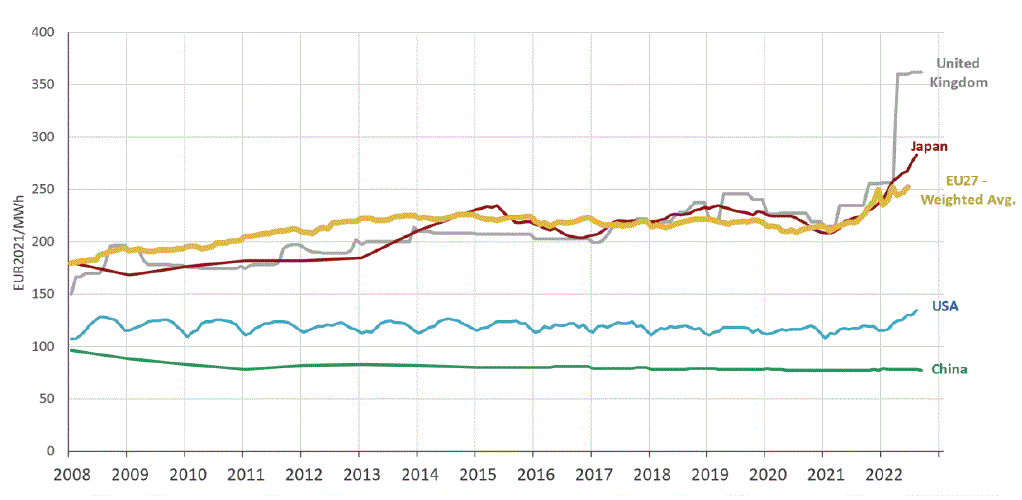
In the next graph is the “rest of the world”. After 2021 Australian electricity prices are unmarked for some reason, but officially they rose 20% two years in a row. So that cost of €210 per MWh in 2021 could easily have become €300 by 2023, putting Australians second highest in the world after the UK.*
The bottom line is that from 2008 the price of electricity in China fell from €100 down to €80 per megawatt hour. While in Australia it rose from €125 to €300 and in the UK prices rose from €150 to €360. Effectively, the price of electricity fell 20% in China at the same time as it rose 240% in Australia and the UK.
If President Xi had wanted to run a campaign to sabotage our grids, he couldn’t have done it better.
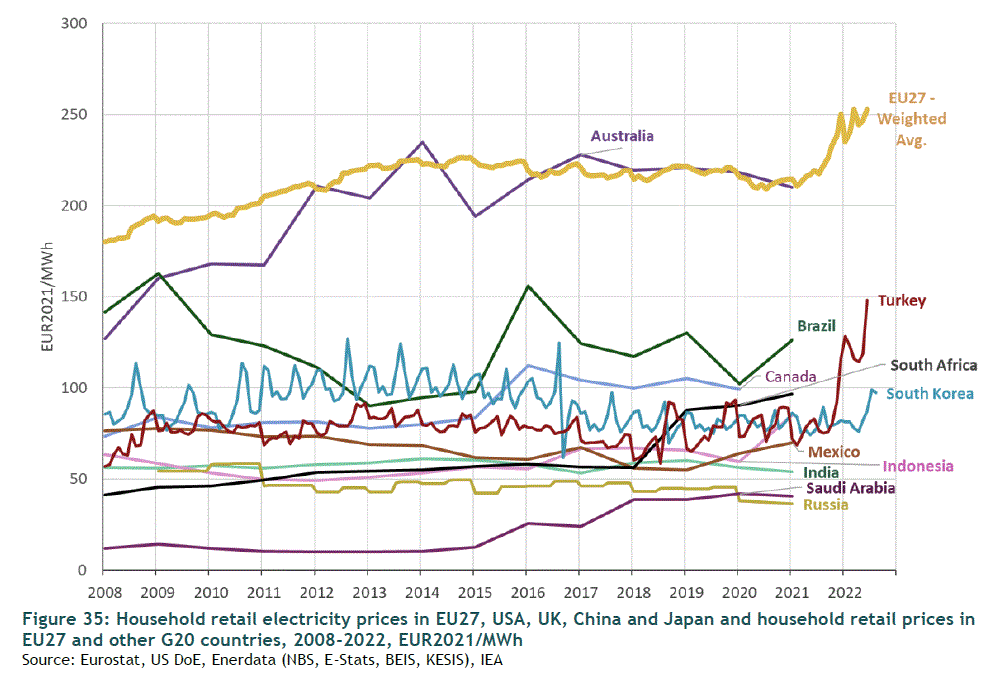
By uncanny coincidence the percentage of wind and solar power penetration on each national grid pretty much predicts the order of the price graphs the EU collated. Among this pool, the nation with the highest penetration of wind and solar power is the UK which gets 29% of its electricity from wind and solar power. Australia is second at 26%, and the EU collective third at 22%. Turkey and Brazil get 16% of their power from the unreliable generators, the USA got 15%, China 14%, Japan 11%, India 9% and Russia 1%.
Japan’s electricity is more expensive than its modest unreliable-generator-percentage would suggest, but then they have virtually no oil, gas or coal to call their own, and no interconnectors to rescue them either.
Is 20% renewables the tipping point?
The three winners of the Highest Price Electricity race are all states with renewable penetration above 20%.
The whole grid can absorb the penetration of unreliable energy up to a point, but there comes a time when adding more random energy generators is a burden too far. The system costs start to breed like Ebola, as the good generators get euthanized, storage costs get out of hand, frequency stability becomes an issue, and everyone wants their own personal interconnector. Then word spreads that the bird killing, bat destroying and whale shredding equipment is noisy, ugly and a fire risk, and before you know it, farmers need 100 times the money to make the high voltage towers bearable. It all just adds to the cost. And finally everyone realizes that the environment you were supposed to be protecting is being clubbed by a windmill, and Florence the borer is stuck in tunnel.
Smaller grids or countries without interconnectors will hit that tipping point faster. Watch this space, world. There is no nation over the border to rescue the Australian grid.
* Estimating the unlisted Australian price leap: the ACCC here found domestic retail bills jumped from $1400 annually to $2000 in NSW, and $1200 to $1600 in Victoria. (p66). In Australia the retail electricity rates now roughly average 33c per kilowatt hour, with a range of 26-45c/KWh (AUD). But that useage cost doesn’t include all the charges. As Craig Kelly points out the €250/MWh European rate is effectively 25 euro-¢/kWh. But the official “Default offer” in South Australia is $0.68 kWh (or 41 euro-¢/KWh). In NSW it is $0.53 – $0.56 kWH (32-34 euro-¢) and in Queensland it is $0.50 kWH (30 euro-¢). So Australia really is more expensive than the crazy-land EU. And while traditionally few customers paid the “default offer”, in 2023 as many as 40% of customers on flat rate plans were paying that rate, according to the ACCC (p47).
h/t to Schroder, thank you, and @CraigKellyPHON.
REFERENCES
European Commission, Directorate-General for Energy, Smith, M., Jagtenberg, H., Lam, L. et al., Study on energy prices and costs – Evaluating impacts on households and industry – 2023 edition, Publications Office of the European Union, 2024, https://data.europa.eu/doi/10.2833/782494
Or https://op.europa.eu/en/publication-detail/-/publication/3b43f47c-e1c5-11ee-8b2b-01aa75ed71a1/language-en/format-PDF/source-316287713
Inquiry into the National Electricity Market: December 2023 Report, ACCC, Australia, December 2023.
10 out of 10 based on 79 ratings
9.9 out of 10 based on 7 ratings
8.6 out of 10 based on 14 ratings
9.7 out of 10 based on 12 ratings

By Jo Nova
It’s just another signpost on the way to the Great Green Economy Downunder
We’re watching the renewable bubble pop around us. Tritium was the wonder-child Australian technology business that built fast chargers for electric vehicles. It took 20 years to create, and only two years to unravel into receivership. At its peak in 2021, it launched on the NASDAQ and was worth $2 billion, now it is insolvent.
The Driven, explains just how big it was:
The company says it has sold more than 13,000 DC fast chargers in more than 40 countries. At its peak it claimed to be the biggest maker of fast chargers in the US with a 30 per cent market share (unclear if this included the Tesla network), and a 75 per cent share in Australia, and one of the top three in Europe.
When it launched in 2021, shares were selling for $2,500 each. The current price is $1.35.
Tritium is the perfect emblem for the Technocratic Planned Economy
Only one year ago the Prime Minister of Australia was raving about them, and using Tritium as the posterchild to sell his new $15 billion “National Reconstruction Fund” to “build sovereign capability”.
During his visit, the Prime Minister said, “This is my third visit to Tritium. Every time I come back, I hear about more revenue, more jobs being created, and more countries where Australia is exporting to. This is a great success story here and I congratulate everyone at Tritium for their achievements.”
Nick Bonyhady and Tom Rabe at The Australian Financial Review point at energy prices:
A Nasdaq-listed electric vehicle fast-charger company hailed first as a Queensland success story and then as a justification for government subsidies is the second major Australian manufacturer to collapse this week.
Tritium’s demise comes just days after Australia’s largest plastics producer, Qenos, was placed into administration, and as an industry chief warns that rising east coast gas prices will continue to threaten a range of domestic manufacturing across the country.
In 2021 Australia was the world’s largest exporter of LNG but in a quest for climate purity we’ve banned so many exploration sites, and pursued so many stupid energy options we are about to start importing gas.
” Gas industry leaders have labelled “bizarre” and unbelievable the likelihood that Australia could soon start importing gas.”
Daniel Mercer, ABC
Peter Tinley [MP] said it made no sense for states to ban the practice of fracking to develop onshore gas reserves while also allowing the import of offshore supplies that were exploited using the same method.
Victoria has banned fracking through legislation since 2017.
“I find it ironic that some jurisdictions ban fracking, for example, but will eventually be importing fracked gas,” Mr Tinley told the Australian Domestic Gas Outlook conference in Sydney. “How do you correlate that?
h/t CO2 Lover, Old Ozzie, David Maddison.
Image by Reto Scheiwiller from Pixabay
10 out of 10 based on 110 ratings
For readers in Perth: David Archibald, long time skeptic and author will be speaking tomorrow.
Topic: “Building Australia’s Defence”
Sunday 21st April at 2.30pm to 4.30pm
David Archibald is the author of: Twilight of Abundance, Australia’s Defence 2016 and Beyond, and American Gripen; The Solution to the F35 Nightmare.
APIWA Club Room, Rear 10 Mallard Way, Cannington, 6107
10 out of 10 based on 12 ratings
By Jo Nova
The Roman Climate Optimum lives
Quietly hidden in a paper about ancient pandemics is the most detailed estimate of Roman temperatures I’ve ever seen. For 800 years temperatures gyrated over a three degree range. The Climate Alarmists of Rome could have run the whole warming-cooling-warming-scare back to back for 400 years. But make no mistake, the good times, Pax Romana — were the warmest and wettest ones. The colder times are associated with aridity, plagues and collapse.
Two thousand years ago plankton bloomed and died, and the different ratios of warm and cool species left thick layers on the ocean floor just off the heel of the boot of Italy. Every ten years another centimeter thick layer of dead dinocysts collected on the sea floor, which makes for a remarkably detailed record. They report a jaw dropping “three year resolution”. The record was so rich they could pick out the seasons, and wow, by golly, they could compare it with modern air temperatures. (See graph A below) Though, for some reason they don’t make that easy, or say much about how those ancient temperatures compare to today. (Presumably, if they found things were hotter today, they’d have got a Nobel Prize.)
Cold times don’t guarantee a pandemic, but warm times do seem to discourage them:
Despite the expert predictions of doom in hot weather, the ancient Roman records don’t suggest mass outbreaks of malaria, flesh eating bugs, or viral pandemics.
Note the words “Present Day mean (1960-1990)” on the horizontal line on Graph B… it was hotter for 200 years in a row.
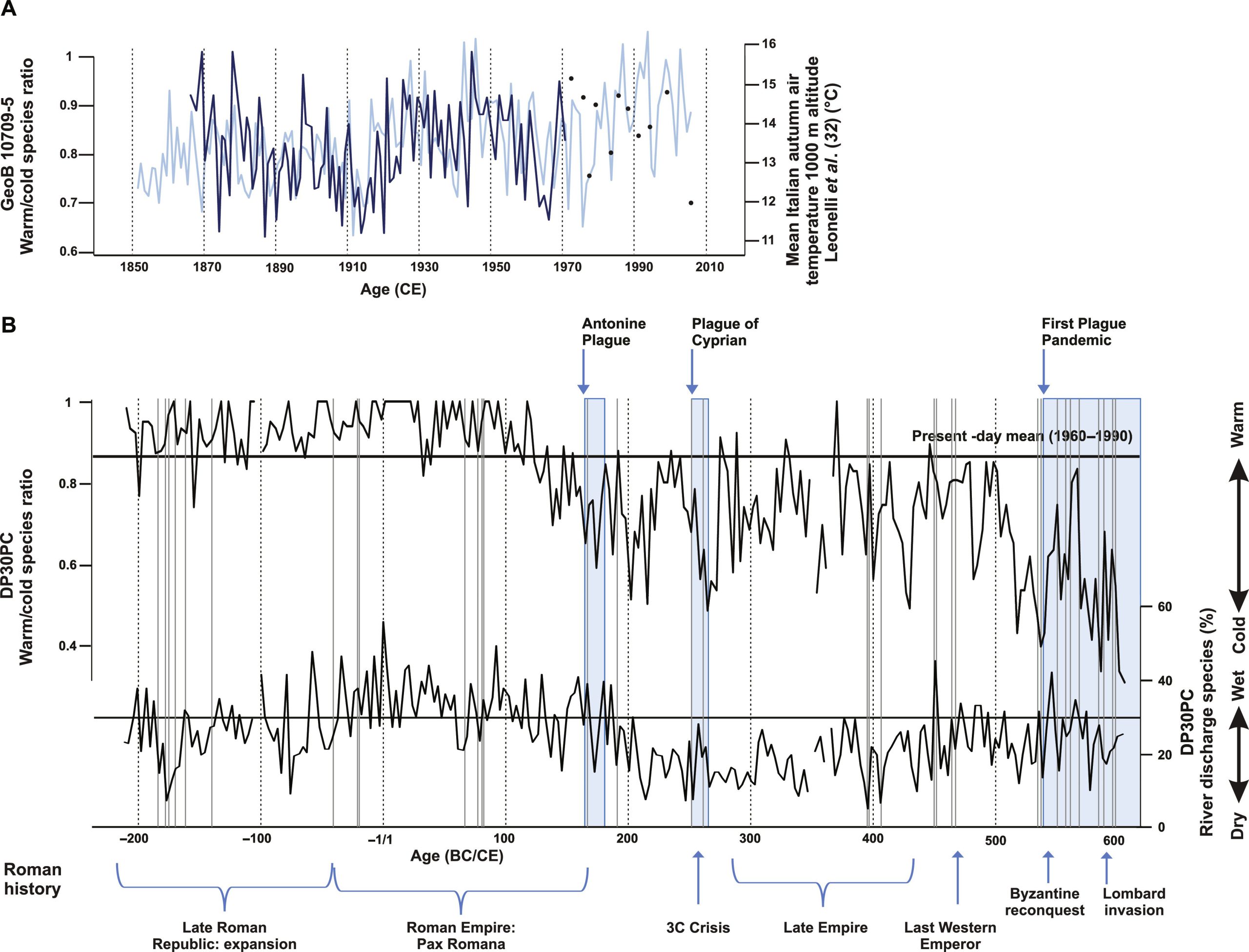 Fig 2A: (Click to enlarge) (A) Comparison between late-summer/autumn dinoflagellate cyst–based W/C ratio (black line + black points) of core GeoB 10709-5 and mean autumn Italian temperatures at 1000-m altitude (blue line). (B) Late-summer/autumn dinoflagellate cyst–based W/C ratio and relative abundance of discharge species (nutrient sensitive) reconstructions (black lines) and the occurrence of epidemics and pandemics in the Roman empire (blue blocks) as well as disease outbreaks in Roman Italy (gray lines) and major historical periods/events. In the paper Graph B is strangely truncated at the hottest points as if their printer jets got clogged. Perhaps the heat broke some climate models? Just how hot was that spike in the era of Jesus? I’d like to get that data…
The plagues
The Antonine Plague, from about 165 to 180 AD was probably smallpox, no one is sure what the Plague of Cyprian was, from about 215 to 266 AD; it might have been measles, smallpox, or some relative of Ebola. At it’s worst 5,000 people a day were said to be dying in Rome. In Alexandria one historian estimates the population fell from half a million people to just 200,000. The Plague of Justinian was a form of Black Plague. It started from about 541 to 549AD, and they say rather somberly, lasted on and off until C.E. 766. Long live hygiene and antibiotics, eh?
The researchers can only speculate about why the pandemics spread more often in the cold. They don’t mention the word vitamin. But the first thing I would suggest is vitamin D3 — levels of which probably fall the minute people get out of their Toga’s and pull on their jackets.
The Antonine Plague of 165 A.D. — Smallpox
If you want to feel lucky, read Edward Watts description in The Smithsonian of what life was like in 165 AD:
Victims were known to endure fever, chills, upset stomach and diarrhea that turned from red to black over the course of a week. They also developed horrible black pocks over their bodies, both inside and out, that scabbed over and left disfiguring scars.
For the worst afflicted, it was not uncommon that they would cough up or excrete scabs that had formed inside their body. Victims suffered in this way for two or even three weeks before the illness finally abated. Perhaps 10 percent of 75 million people living in the Roman Empire never recovered.
The plague waxed and waned for a generation, peaking in the year 189 when a witness recalled that 2,000 people died per day in the crowded city of Rome. Smallpox devastated much of Roman society. The plague so ravaged the empire’s professional armies that offensives were called off.
And when communities began to buckle, Romans reinforced them. Emperor Marcus Aurelius responded to the deaths of so many soldiers by recruiting slaves and gladiators to the legions. He filled the abandoned farmsteads and depopulated cities by inviting migrants from outside the empire to settle within its boundaries.
Apparently things were so bad that in some cities so many aristocrats died they even filled the councils with “the sons of freed slaves”.
The temperatures from graph B above are marked in the figure below (just in case you don’t relate to phytoplankton ratios).
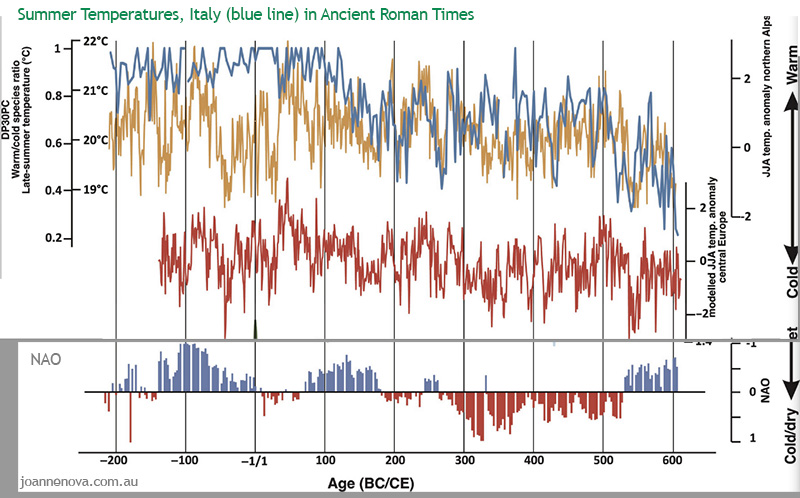 Core DP30PC and paleoclimatic records. Dark blue: Gulf of Taranto, late-summer temperature reconstruction based on dinoflagellate cyst composition (this study); orange: Northern Alps, June to August dendrochronological-based temperature reconstruction (3); red: proxy-based central European, June to August (JJA) temperature reconstruction (33) The currents flow right down the side of Italy before depositing some phytoplankton in the Gulf of Taranto where the samples were collected..
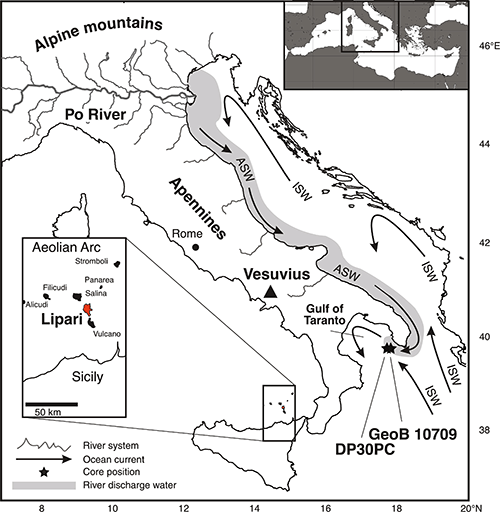 … For the record, here’s how they describe the calibration:
The calibration of our dinoflagellate cyst–based temperature proxy is based on the comparison of the cyst association of a reference dataset from multicore core GeoB 10709-5 (29) to mean Italian late-summer/autumn air temperatures (32).
For some reason the researchers have this magnificent temperature record, and they calibrate it with modern temperatures but said nothing at all about how the Roman Optimum compared to the 21st Century. Luckily, we already know from other studies it was hotter back then. Must have been all those Roman coal plants?
h/t Judith Curry and Tom Nelson
REFERENCE
K. A. F.Zonneveld et al (2024). Climate change, society, and pandemic disease in Roman Italy between 200 BCE and 600 CE Physics Today 77 (4), 17–18 (2024); https://doi.org/10.1126/sciadv.adk1033
Margaritelli, G., Cacho, I., Català, A. et al. (2020) Persistent warm Mediterranean surface waters during the Roman period. Sci Rep 10, 10431. https://doi.org/10.1038/s41598-020-67281-2
Garcia-Solsona, E.; Pena, L. D.; Paredes, E. ; Perez-Asensio, J.N.; Quirós-Collazos, L. ; Lirer, F.; Cacho. I. (2020) “Rare Earth Elements and Nd isotopes as tracers of modern ocean circulation in the central Mediterranean Sea”. Progress in Oceanography, June. Doi:/10.1016/j.pocean.2020.102340
See also the write up in Physics Today.
*Figure 2 headline altered to clarify the role of the blue line. 19/04/2024.
10 out of 10 based on 80 ratings
9.7 out of 10 based on 7 ratings

By Jo Nova
Buy my weather changing machines before midnight and I’ll save you $38 Trillion dollars and throw in some rainy days (or sunny ones, whatever you need).
Trust me, Earth’s Chief Climate-economist said, while stacking climate models that don’t work on top of crystal balls that forecast the economy. Two failures squared and projected to infinity makes great headlines and a never ending grant.
Their climate models can’t predict the most influential global climate phenomenon on the planet even six months in advance, so 25 year predictions are “obviously” the way to go. (No one will know they were wrong). The El Niño-Southern Oscillation (ENSO) drives heatwaves and floods across the globe but no matter what supercomputer they use, not one of the 23 General Circulation Models of Climate can tell you whether 2025 will be La Nina or El Nino, let alone 2045. We’re in the chicken-entrail days of climate forecasting.
Not one of the UN experts can even name the key variables that drive the ENSO cycle. Is it the solar wind blasting us at a million miles an hour, is it the interplanetary magnetic field, ultraviolet cycles, or cosmic rays? Is it geothermal hot leaks in submarine trenches we haven’t mapped, undersea volcanoes we haven’t measured, or phytoplankton blooms we didn’t even know we needed to pay attention to until last year? Remember how the same geniuses blamed mankind for the horrid benzene and toluene in the vast Southern Ocean for years, only to discover the dang pollutants were made by industrial microbes in the ocean? Both those gases are aerosols that seed clouds far above the ocean, and those clouds are big enough to be mapped from space, but Climate Models go Brrr, and say “give me your money”.
Climate Change Will Cost Global Economy $38 Trillion Every Year Within 25 Years, Scientists Warn
Robert Hart, Forbes
Damages from climate change will set the global economy back an estimated $38 trillion a year by 2049, with a likely range of between $19 trillion and $59 trillion, warned a trio of researchers from Potsdam and Berlin in Germany in a peer reviewed study published in the journal Nature.
To obtain the figure, researchers analyzed data on how climate change impacted the economy in more than 1,600 regions around the world over the past 40 years, using this to build a model to project future damages compared to a baseline world economy where there are no damages from human-driven climate change.
Bragging about “40 years” and 1,600 regions like that means something, is just fawning over mindless big number climate-porn figures. The last 4 million years of “climate change” looks like an earthquake readout and it wasn’t caused by man-made CO2. There are cycles in here that last 40,000 years and cycles we don’t even know about. We have captured one thousandth of one cycle and we’re boasting about it?
 L. E. Lisiecki and M. E. Raymo (2005) This paper in “Nature” the formerly esteemed journal, reads like a sales brochure in the press release. These scientists took lessons from the Mafia:
Even if CO2 emissions were to be drastically cut down starting today, the world economy is already committed to an income reduction of 19% until 2050 due to climate change, a study published in Nature finds. These damages are six times larger than the mitigation costs needed to limit global warming to two degrees.
So based on their models that don’t work, and miss scores of variables, they estimate we should bet trillions, and redesign our entire national economy or our income will be smaller than it was probably, maybe going to be if we didn’t. Satisfaction guaranteed. Just ask us in 25 years and we’ll model how much money we saved you.
_____________________
Jo Nova’s tally of climate model failure continues: the hot spot is still missing, the climate models can’t predict the climate on a local, regional, or continental scale, they don’t know why global warming slowed for years, They can’t explain the pause, the cause or the long term historic climate movements either. Measurements of satellites, clouds, 3,000 ocean buoys, 6,000 boreholes, a thousand tide gauges, and 28 million weather balloons can’t find the warming that the models predict. In the oceans, the warming isn’t statistically significant, sea-levels started rising too early, aren’t rising fast enough, aren’t accelerating, nor are warming anywhere near as much as they predicted. Antarctica was supposed to be warming faster than almost anywhere but they were totally wrong. The vast Southern Ocean is cooling not warming. And the only part of Antarctica that’s warming sits on top of a volcano chain they prefer not to tell you about.
No wonder expert climate modelers don’t want their own pensions bet on climate models.
REFERENCE
Leonie Wenz, The economic commitment of climate change, Nature (2024). DOI: 10.1038/s41586-024-07219-0. www.nature.com/articles/s41586-024-07219-0
L. E. Lisiecki and M. E. Raymo (2005) — A Pliocene-Pleistocene stack of 57 globally distributed benthic δ18O records, Paleoceanography 20, 1003
Image created by Robert A. Rohde / Global Warming Art
10 out of 10 based on 95 ratings
10 out of 10 based on 8 ratings
By Jo Nova
Where are the tears? Elephant Seals and Penguins were forced off the Ross sea 1,000 years ago because it got too cold
One thousand years ago Southern Elephant Seals were happily living in the Ross Sea of Antarctica. Likewise Adelie Penguins frolicked in the sun there during the “Penguin Optimum” of three to four thousand years ago. They had lived there on and off for thousands of years in the Holocene, but the glaciers came back and the cold times returned, and all the colonies were wiped out. All that’s left there now is just their rotting bones and fur as testament to the devastation of Global Cooling.
Thanks to Kenneth Richard at NoTricksZone for his dedication in digging up these papers.
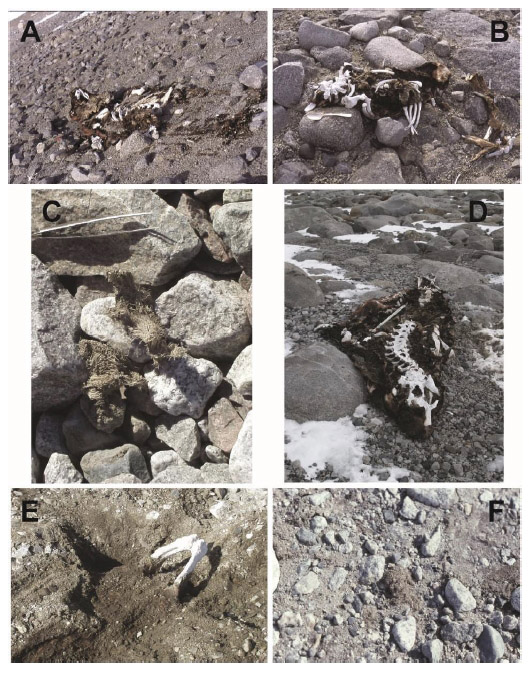
The Ross Sea is a part of Antarctica that is south of New Zealand, and in the pictures below the remains of the seals and penguins show that they had well established colonies in places where they are unable to live now. The red circles mark the seal colonies, and the blue stars show the penguins. The colonies ebbed and flowed but then were lost as the Little Ice Age began and have not recovered.
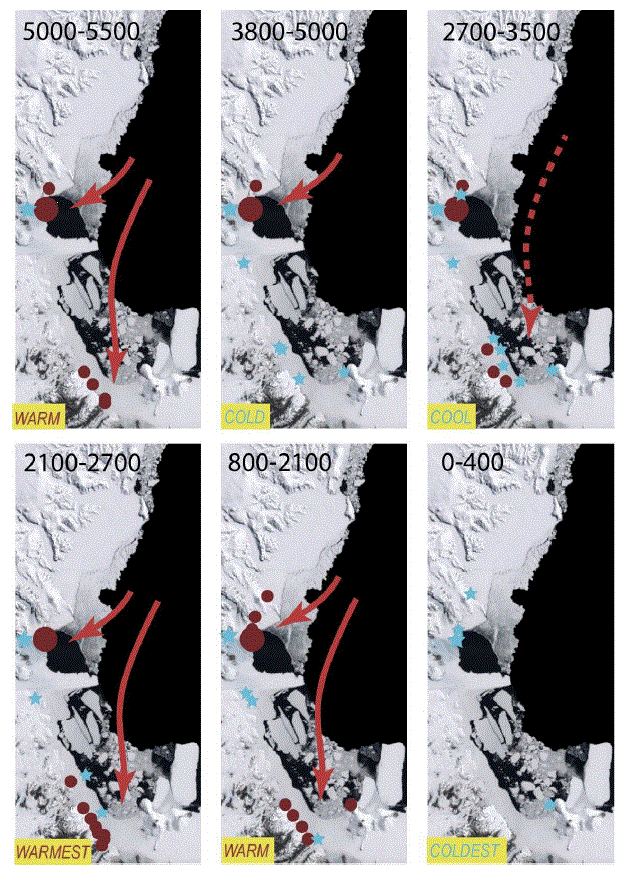
Today the beaches are an empty wasteland:
Today, the beaches are largely free of marine mammals and birds; skuas (Stercorarius maccormicki) are the most widespread species. Along the southern coast, penguins are absent, although small Adélie (Pygoscelis adeliae) rookeries existed in the past (i.e., Baroni and Orombelli, 1991, 1994a; Emslie et al., 2007). Adélies also occur adjacent to Terra Nova Bay at Adélie Cove and Inexpressible Island. Solitary or small groups of Weddell seals (Leptonychotes weddellii) occasionally haul out on the VLC. No other seals use these beaches at present.
The seals and penguins of Antarctica must be desperately hoping for some global warming so they can return to their ancestral homes and flourish where only desolate ice grips the sea and shore now. If only humans could do something about that!
Indeed, it’s time to launch a new campaign: “Fossil fuels can save the seals”. (It has just as much scientific validity as any eco-campaign running today, ask the IPCC!).
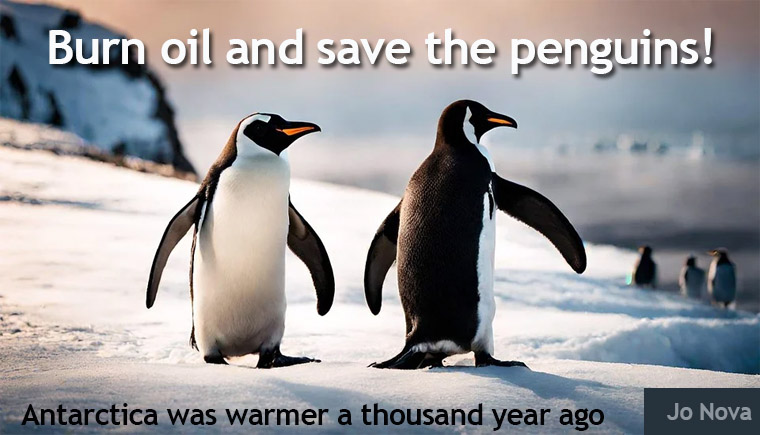 …
I don’t believe human emissions can warm the planet enough for the penguins to notice, but what if I’m wrong?
There really was a “Penguin Optimum” at about the same time as the Minoans and the Myceneans thrived. Bring back the warmth!
The red and yellow bars mark warmer eras where the marine mammals flourished. The diatom results marked in blue at the bottom (F. curta) of the graph below, show how sea ice expanded in the last thousand years as the cold made life impossible for the seals and penguins. The diatom results marked in red (T. antarctica) rise in the eras of longer warmer summers. The graph above runs “backwards” in time from right (the past) to left (present).
 Fig. 7. Synthesis of Holocene climate records from the northern VLC discussed in the text. A. Age distribution of seal remains at Terra Nova Bay. B. Cadmium/phosphorus ratios of penguin guano at Inexpressible Island, inferred to be a proxy for the presence of modified circumpolar deepwater in Terra Nova Bay (Xie et al., 2021). C. Diatoms from a marine core at nearby Wood Bay (Fig. 1; Megzec et al., 2017), inferred to represent sea-ice extent (F. curta (blue) – high % = more sea ice) and summer temperature/duration (T. antarctica (red) – high % = warmer/longer summer). Green bar and arrow at the top of the figure denote the penguin optimum (Baroni and Orombelli, 1994) and decline of penguin rookeries at southern mainland locations. Red and yellow bands are from Fig. 6 and indicate times of relative warmth inferred from the elephant seals. Tell the children, the world was warmer a thousand years ago, and the cooling has been a killer. If they like life on Earth, they want more warming, not more cooling. The world has been cooling for 5,000 years, and if we could warm the Earth that would be a good thing.
See these posts for references:
REFERENCE
Hall et al (2023) Widespread southern elephant seal occupation of the Victoria land coast implies a warmer-than-present Ross Sea in the mid-to-late Holocene, Quaternary Science Reviews, Volume 303, 1 March 2023, 107991
10 out of 10 based on 74 ratings
10 out of 10 based on 8 ratings
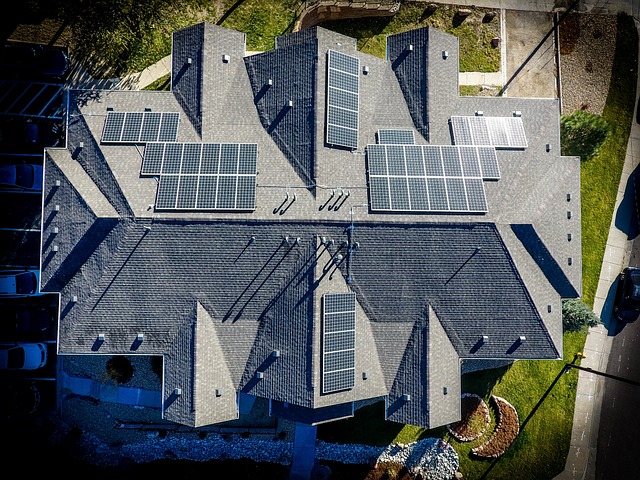 By Jo Nova By Jo Nova
California was the Land of Solar Panels at the top of the Magic Subsidy Tree but that boom went bust
If solar panels were actually cheap and useful, everyone could have them, they’d pay for themselves, and there would be no point where the panel-party would grind to a halt. But if they were expensive, made something useless, and their product became toxic to the grid itself the government would have to artificially subsidize them to get them onto the grid in the first place, and then pop its own bubble before the bubble popped the grid. And so that time has arrived in California and there is carnage in the market.
The Duck has quacked
In a strange coincidence the Californian government cut the payments for solar-powered-electricity by 75% last year, and sales of solar panels fell to a quarter of what they were a year ago. That’s a “to” not a “by”. One in five solar contractors has already left the market. Careers and businesses — gone.
The new price for solar-powered-electricity is probably slightly closer to the true market value, which is almost zero, or even less for holy-green electricity at noon. The Duck Curve is the shape the daily load curve makes. As more and more solar panels are added to the grid the demand for electricity falls at midday, but stays the same at breakfast and dinner. So the amount of electricity required for the state gradually develops a “belly” at noon, and looks like a duck. As more solar panels are added, the grid ends up with too much electricity at midday, which is such a problem it has to pay someone else to use it. In a real free market, negative wholesale prices at midday should have killed off the solar panel rooftop industry years ago.
by Phred Dvorak, The Wall Street Journal
Nation’s biggest residential solar market is tanking and installations could decline 13% nationwide, despite clean energy push
The state has installed so many panels that it has a glut of solar power during the day. Last year, California implemented new rules that cut the amount of compensation most rooftop solar owners get for the electricity they send to the grid by 75% or more to manage the oversupply and soaring costs for upgrading the grid.
Residential solar sales have dropped to a quarter of what they were a year ago, and more than a fifth of the state’s solar contractors have been laid off, according to some estimates.
“It was like getting a gut punch,” says Carlos Beccar, marketing director of Fresno-based Energy Concepts, a solar installer that had to lay off more than half its 75 employees after sales plummeted as much as 90% following the new rules.
The journalists spin the solar excuses
At the same time, California’s solar growth is outpacing the ability of its grid to handle it.
It’s not that solar-electricity is a useless toxic byproduct of subsidies, it’s that solar is so good, the grid is not ready for it. In other words, it’s all your fault. You need to pay more for that grid “upgrade”, or storage, or something so the little solar flowers can thrive.
Who knew, the job of the grid was not to supply electricity, but to “absorb” the subsidy farmers:
The state already supplies more than a third of its power with renewables, and it plans to raise that ratio to 60% by 2030. But because the state’s grid can’t absorb all the solar power generated during the day, it ends up throwing increasing amounts of it away or curtailing it.
Get ready, the next step is to corral us into paying more to solve the mess they created:
Part of the rationale behind the state’s new solar billing rules is to encourage households to buy batteries, which can store power for use later.
See how the planned economy works? The subsidies forced useless white elephants onto the grid. The fees to cover the costs were set so the people without solar had to pay the subsidies. So their electricity bills went up until their wallets bled, and they begged to buy solar panels “because electricity costs had risen”. Then the government changed the conditions so that people with solar really needed to buy a battery …
More than 30% of homes in Australia have solar panels installed. In California, in 2019 apparently 44% of homes had solar panels. But as extreme as that is, California is connected to other states in the US, so it can offload the extra electricity, or upload electrical juice from other reliable generators. Australia doesn’t have that option. We have to put the spare electricity in shoe boxes and float it over to Papua New Guinea.
Image by Charlie Wilde from Pixabay
9.9 out of 10 based on 102 ratings
8.2 out of 10 based on 5 ratings
“We are more divided as a nation than ever and are feeling increasingly disillusioned and disempowered.”
Hon. John Anderson | Brendan O’Neill (Spiked Magazine) | Tony Seabrook (PGA) | Janet Albrechtsen (The Australian) | Jennifer Grossman (CEO of the Atlas Society) | Scott Hargreaves (IPA) | Professor Stephen Wilson | Professor Simon Haines (Ramsay Centre for Western Civilization) | Dr. Bella D’abrera | Russell Delroy | Steve Whybrow Sc | Professor Gary Banks | Gemma Tognini | Dan Ryan | Brianna Mckee | Freya Leach | Ron Manners (Mannkal)
Sydney, April 23rd | An evening with Brendan O’Neill (CIS)
Sydney, April 30th | Australia’s Nuclear Future (CIS)
10 out of 10 based on 21 ratings

By Jo Nova
Electric cars and carbon target fantasies are hitting the wall
Right when they are meant to be growing by double digits German EV car sales are down an astonishing 30% compared to a year ago. Their market share is actually shrinking. EV’s are not much good at reducing carbon dioxide over their lifetime but they are very useful for pretending to “decarbonise” the transport sector. So this creates a vast hole in the German government’s so-called transition, which has fixed targets for every sector. Problematically, the transport sector just doesn’t seem to run on wind and solar panels, or pumped hydro. It’s hard to decarbonize. Liquid fuel is just too convenient.
It seems the German Transport Minister is threatening to ban weekend driving as an ambit claim to expose the absurdity of the Green’s position. He is warning that if the Greens don’t sign a change in legislation to average emission across all sectors, he will have to take drastic action to meet the transport sector goals, which means banning driving on weekends. (Trap set.)
The Greens responded like any petty tyrants would, saying he shouldn’t aggravate people unnecessarily, because there were other ways to fix the climate, like forcing everyone to drive slower. (Trap sprung.) The Greens stepped right into it:
“This claim is simply wrong,” Green parliamentary group leader Julia Verlinden told the German Press Agency, referring to Wissing’s threat of a weekend driving ban. She added that Wissing should not aggravate people unnecessarily because there are other ways to tackle climate issues, such as a speed limit. — Politico
Naturally, at the next election, policies that make people drive slower to stop storms 80 years from now will sink like a boat full of burning cars.
Volker Wissing (the Transport Minister) is a member of the Free Democratic Party (FDP) which is theoretically a centre right party. Because the German government is a “traffic light coalition” of three different parties, he needs to work with the Greens to get legislation passed, but he doesn’t have to help them win the next election.
As Pierre Gosselin at NoTricksZone points out the German government are not even close to hitting their EV targets: “The massive sales drop is bad news for the current German socialist-green government, which aims to have 15 million vehicles on the road by 2030. Currently there are just 1.4 million!”
So they’re 13.6 million cars short with only 5 years and 9 months to get there. At the current rate of sales they’re going miss their target by 11 million cars.
Germany’s ambitions to take a leading role in electromobility suffered a severe setback in the first quarter of this year. A significant drop in sales is emerging. Only 31,384 electric vehicles were newly registered in March, a drastic decrease of 28.9 percent compared to the previous year. The collapse in registrations contrasts with the political goals and underlines the gap between political planning and actual market conditions. The challenge lies in whether political measures are effective enough to counter consumer preferences and market dynamics
Electric car shock: market share falls to 11.9% – end of subsidies exposes Germany’s dilemma
The abolition of the electric bonus at the end of 2023 has revealed another problem. The sector’s dependence on government subsidies became visible. This has further exacerbated the crisis of confidence in the electric car market.
And so we arrive at the ugly point where the planned economy meets the real one:
By Šejla Ahmatović Politico, [Translated by Google]
The ruling coalition has been fighting over legislation that sets out binding climate targets.
Germany’s transport minister is threatening to ban driving on weekends to meet climate goals if the ruling coalition does not pass reforms to the Climate Protection Act by July.
A reduction in traffic to help meet the climate goals would only be possible through measures that are difficult to communicate to the public, such as “comprehensive and indefinite driving bans on Saturdays and Sundays,” Wissing added.
All Wissing is asking for is to spread the emissions reductions over other sectors:
The planned amendment to the emissions-reduction law allows climate goals to be reviewed for compliance by looking at all sectors together instead of individually. If the overall target is missed two years in a row, then the federal government is to decide in which sector and with which measures the permitted total amount of carbon dioxide emissions is to be achieved by 2030.
If the planned reforms are not passed through parliament by July 15, Wissing warned, the Ministry for Digital and Transport would be obliged to submit an “immediate action program that ensures compliance with the annual emission levels of the transport sector” until 2030 — which would include a driving ban on weekends.
Wissing has already said the government is not looking to put speed limits on highways. He’d probably quite like it if the Greens adopt that policy at the next election. The Greenpeace mobility expert (as if there is such a thing) is Clara Thompson who said that Wissing was coming up with “horror” scenarios to distract from his own failures. But at least as far as Politico reports it, she didn’t have any suggestions of how to solve electric vehicle nightmares with frozen batteries, slow charging, expensive repairs, car sickness, combustible materials, and holiday hell stories.
h/t John Connor II
10 out of 10 based on 92 ratings
8.7 out of 10 based on 13 ratings
8.2 out of 10 based on 22 ratings
|
JoNova A science presenter, writer, speaker & former TV host; author of The Skeptic's Handbook (over 200,000 copies distributed & available in 15 languages).

Jo appreciates your support to help her keep doing what she does. This blog is funded by donations. Thanks!


 Follow Jo's Tweets
Follow Jo's Tweets To report "lost" comments or defamatory and offensive remarks, email the moderators at: support AT joannenova.com.au
Statistics
The nerds have the numbers on precious metals investments on the ASX
|






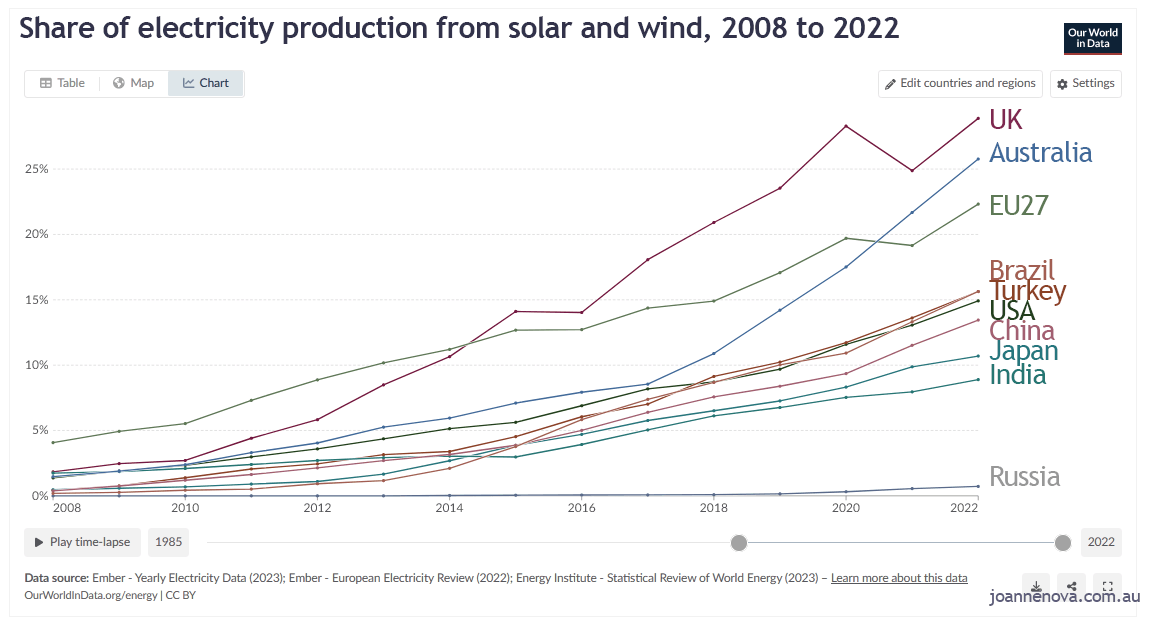











 By Jo Nova
By Jo Nova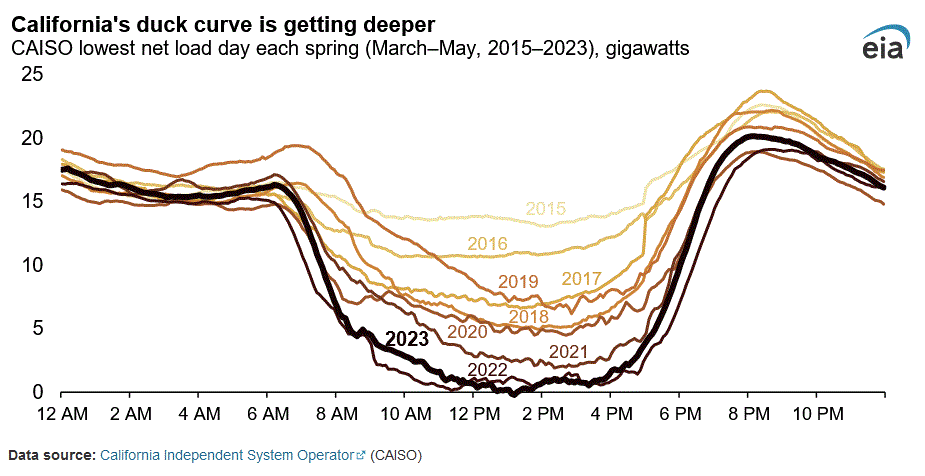












Recent Comments